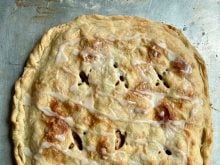There is a sign on Veronica Montgomery’s fridge door that says, “quitting is not an option.”
These motivational words were given to her by one of her university professors, Bev Pain.
Montgomery is a single mom with four children who travels an hour and a half each way to university. She is taking a bachelor of education degree with a home economics major. She returned to school after 18 years away to improve opportunities for her family. This has not been an easy decision and she has wanted to quit and leave the financial, emotional and study struggles behind.
Read Also

From farmer to award-winning distiller
Pivot Spirits showcases transition from farmer to distiller with provincial award-winning results in Alberta for Lars Hirch
On March 27, at a World Home Economics Day breakfast held at the University of Saskatchewan, she received a $1,000 scholarship from the Saskatoon branch of the Association of Saskatchewan Home Economists. She thanked fellow students, faculty and other home economists for their support.
Encouraging students by sharing home economics career experiences was the theme of the breakfast. Home economics is a diverse profession that provides many opportunities, most of which focus on sharing information. Many present had been educators in the school system or for adult education while some had worked in Ghana to develop home economics education programs and textbooks. Writing and editing were common activities of many working and retired home economists. The range of experiences included newspaper columns, cookbooks, commodity group promotional information, textbooks, high school curriculum and computer websites. “Quitting is not an option” was a theme that applied to many of the retired home economists as they continue to seek out work or volunteer in their communities.
Readers’ letters
Dear TEAM: One of your readers mentioned their problem with aphids on dill. For years I had trouble with aphids until I discovered that aphids do not like marigolds. Since planting my dill in a bed of marigolds, aphids have not been a problem. – I.B., Regina, Sask.
Dear TEAM: I have an
Aebleskiver pan. I need to know what to make in it and how to cook it. I bought it at a secondhand store. – C.W., Shell Lake, Sask.
Dear C.W.: I had never heard of this type of pan so I found it quite interesting to discover the history, use and recipes for it.
Aebleskiver, meaning apple slices, are traditional Danish cakes, somewhat similar in texture to pancakes. Aebleskiver are cooked in a special cast-iron pan with several hemispherical indentations in the bottom of the pan, giving the cakes their round shape. If you don’t have a special pan, use a heavy muffin pan.
Aebleskiver are often cooked with bits of apple or applesauce inside. This light pancake ball is also known as the Danish doughnut. They are sweet and are traditionally sprinkled with powdered sugar, accompanied with strawberry marmalade. They are often served on Christmas Eve.
The authentic way to turn the aebleskiver in the pan is with a knitting needle, however, some prefer chopsticks because they are more sensitive when testing for doneness.
Danish Aebleskiver
This recipe came from Denmark in the 1890s.
2 cups all-purpose flour 500 mL
2 tablespoons margarine 30 mL
or butter, melted
2 cups buttermilk 500 mL
3 eggs, separated
2 tablespoons sugar 30 mL
1 teaspoon baking soda 5 mL
1 teaspoon baking powder 5 mL
1/2 teaspoon salt 2 mL
In medium bowl beat egg whites until stiff peaks form, then set aside. In large bowl beat egg yolks and sugar until well blended. Add all remaining ingredients except egg whites. Beat until smooth. Fold in egg whites until well blended.
Heat aebleskiver pan over medium heat until drops of water sizzle. Add some oil or fat to each indent. Using about one tablespoon (15 mL) batter, fill the greased indents in the aebleskiver pan about half full. Once a crust has formed on the aebleskiver they should be turned frequently during baking until golden brown in colour, about three minutes. Balls are done when a wooden pick inserted in centre comes out clean. Roll in sugar and serve hot. Makes 35 pancake balls of about 45 calories each.
Yeast Aebleskiver
2 cups flour 500 mL
1 tablespoon sugar 15 mL
1/2 teaspoon salt 2 mL
2 tablespoons yeast 30 mL
2 cups light cream 500 mL
or milk
3 eggs
Sift flour with sugar and salt. Mix yeast with lukewarm cream or milk. Add eggs, one at a time. Combine
all of the ingredients. Leave for
approximately two hours to rise. Bake in aebleskiver pan to golden brown at low heat.
Note: One teaspoon (five mL) of baking powder could be added instead of the yeast, then the cream should not be heated and the
aebleskiver should be baked at once. A little applesauce or pieces of apple could be added while baking. Serve with either sifted confectioners
sugar, blackberry jam or both.
Readers’ Easter recipes
When we had our cookbook draw at Christmas, readers sent in their holiday traditions recipes. Here are a few Easter recipes that were sent in at that time.
Dear TEAM: We have nalysnyky for brunch at Easter. I make it the day before and bake it the next morning. I hope you enjoy it. – D.S., Shamrock, Sask.
Nalysnyky
Batter:
6 eggs
1 cup milk 250 mL
1 cup water 250 mL
1 teaspoon salt 5 mL
11/2 teaspoons baking 7 mL
powder
11/2 cups flour, unsifted 375 mL
Mix everything together in a blender. This can be mixed by hand but the blender is easier. Batter should be watery when finished. Make pancakes by pouring 1/3 cup (75 mL) batter into a lightly greased frying pan. Fry on medium heat. One side should be lightly browned and the other side cooked, but not browned.
Filling:
2 cups dry curd 500 mL
cottage cheese
1 egg
1/4 cup cream or half 60 mL
and half
1/2 teaspoon salt 2 mL
2 tablespoons sugar 30 mL
Mix all the ingredients together. Spread one heaping tablespoon down the centre of the “not” browned side of each pancake. Fold in sides and roll up like a cabbage roll. Put them in a lightly greased casserole or cake pan. Spoon about one cup (250 mL) applesauce over the rolls, then sprinkle with cinnamon. At this stage they can be kept in the fridge until you’re ready to bake. Before baking, pour one pint (500 mL) whipping cream over everything. Bake at 350 F (180 C) for 25 minutes, covered. A little longer if they were refrigerated. Serve plain or with syrup.
Dear TEAM: I serve this scalloped corn at Christmas, Easter and Thanksgiving as one of my family’s favourite recipes. It is a must. – V.M., Weyburn, Sask.
Scalloped corn
2 cans (14 oz.) each 398 mL
creamed corn
2 eggs
1/2 teaspoon salt 2 mL
1/4 teaspoon pepper 1 mL
3/4 cup milk or less 175 mL
30 single soda crackers,
crushed
11/2 tablespoons butter 22 mL
or margarine
Beat eggs and add to the corn. Add salt, pepper and milk. Mix and pour into a well greased casserole dish. The corn mixture should not be real runny. Top with crackers and dabs of butter or margarine. Bake at 325 F (160 C) for about two hours.
Dear TEAM: When my husband and I married in 1986, my mother-in-law shared a recipe that she always prepared for Easter and other family gatherings. It’s a wonderful salad that goes great with turkey. It’s so delicious that the kids eyeball it as it is passed around, hoping that there will be enough for a second helping. – J.W., Saskatoon.
24 hour salad
2 eggs, beaten
1/4 cup vinegar 60 mL
1/4 cup sugar 60 mL
2 tablespoons butter 30 mL
1 can (14 oz.) well-drained
fruit cocktail 398 mL
2 cups miniature 500 mL
marshmallows
1 cup whipping cream 250 mL
1 orange, cut into small pieces
in a small cup with sugar
Put eggs in a double boiler and add vinegar and sugar, beating constantly until thick and smooth. Remove from the heat. Add butter and cool. When cool, fold in fruit cocktail and whipped cream, then marshmallows. Pick out orange pieces from the sugar and add. Let stand in the fridge at least 24 hours.
Betty Ann Deobald is a home economist from Rosetown, Sask., and one of four columnists comprising Team Resources. Send correspondence in care of this newspaper, Box 2500, Saskatoon, Sask., S7K 2C4 or contact them at team@producer.com.














